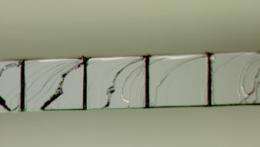Scientists Develop New Laser-Machining Techniques for Radiation Detectors

(PhysOrg.com) -- Scientists at the Naval Research Laboratory have developed new laser-machining techniques for radiation detectors. "The new detectors will enable the next generation of space-based high-energy radiation astronomical research and might also be used for homeland security applications," explains Dr. Bernard Phlips, who heads the NRL team.
The Radiation Detection Section in NRL's Space Science Division is developing novel radiation detectors based on hole- or trench-arrays in semiconductors. These types of detectors are often called three-dimensional (3-D) detectors. A widely spaced hole-array is desirable in that it allows lateral depletion and charge collection. This decreases the device thickness and depletion voltage and consequently reduces material quality requirements and cost of the detector material. The radiation detectors that will be produced with these new NRL-developed techniques will have a smaller size and substantially lower weight and power consumption than current state-of-the-art devices.
The NRL team developed novel ways to laser-micromachine hole-arrays in a variety of semiconductors, including silicon (Si), Cadmium Telluride (CdTe) and Indium Phosphide (InP). Their reproducible new fabrication methodology is the critical process step for 3-D hole-arrays detector development. The resulting laser-machined holes have a much higher aspect ratio (diameter to depth ratio) than holes achieved with standard fabrication techniques. For example, laser-micromachined hole-arrays into silicon that have been developed at NRL have aspect ratios up to 100:1, while traditional techniques allow a maximum of only 40:1.
NRL's laser-micromachining hole-arrays work is being performed at NRL's Institute for Nanoscience (NSI), which has just installed a new Oxford Laser E-Series micro-machining system that is making this work possible. Dr. Marc Christophersen, from NRL's High-Energy Space Environment Branch, who developed the novel laser-machining techniques, is the NSI custodian for the Oxford Laser micromachining system. In addition to performing his own research on the system, Christophersen is responsible for user training, tool maintenance, and the initial tool start-up.
Provided by Naval Research Laboratory















